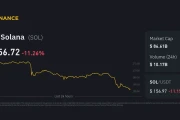Title: Crypto Bloodbath: Is Solana's $165 Line in the Sand the Last Stand f...
2025-11-04 11 solana price
Bitcoin took a nosedive from $112,000 to under $106,000 on Monday, and the carnage was swift. Over $1.27 billion in leveraged futures positions got wiped out across crypto markets. The scale of this flush raises the key question: Was this the bottom, or just a prelude to further declines? Let’s dissect the numbers.
CoinGlass data paints a stark picture. Long traders got absolutely hammered, accounting for almost 90% of the total liquidations. We're talking about $1.14 billion in bullish bets gone up in smoke as prices retreated from their weekend highs. Shorts? They only suffered $128 million in liquidations. That’s a nearly 9:1 ratio favoring long liquidations. A lopsided bloodbath, to put it mildly.
Liquidations, for those unfamiliar, happen when traders using borrowed money get forced to close their positions because their margin can't cover the losses. Crypto exchanges automate this process. When prices move sharply against a leveraged trade, the platform sells the position to cover the debt. It's brutal, but it's how the system avoids cascading defaults. The single biggest liquidation occurred on HTX, where a $33.95 million BTC-USDT long position was closed out. Ouch.
Large long liquidation clusters can signal capitulation and potential short-term bottoms. The reasoning is simple: all the weak hands have been flushed out, leaving room for more stable, spot-driven buying to take over. Conversely, heavy short wipeouts often precede local tops as momentum shifts. Traders also watch where liquidation levels are concentrated to identify zones of forced activity that can act as near-term support or resistance. Hyperliquid saw the most activity, with $374 million in forced closures (98% longs), followed by Bybit at $315 million and Binance at $250 million. (These figures highlight the concentration of leveraged trading on specific platforms.)
Here's where my analysis gets a little more nuanced. While a liquidation event of this magnitude can signal a bottom, several factors suggest caution. The flush happened after Bitcoin got rejected above $113,000 amid thin order books. This amplified price swings as cascading liquidations hit during low-liquidity hours. It's like a dam breaking during a drought – the impact is far greater than it would be during a normal rainy season.

The report claims that these events typically mark short-term “clearing moments” where leverage resets and spot buyers step back in. But “typically” doesn’t mean “always.” Despite the carnage, open interest remains near $30 billion, and funding rates have eased only slightly. Traders still seem wary of further volatility ahead of the Fed's rate decision later this week. This hesitancy suggests that the market hasn't fully reset. And this is the part of the report that I find genuinely puzzling. If the market truly believed this was a bottom, wouldn’t we see more aggressive dip-buying and a faster recovery in funding rates?
Ethereum and Solana felt similar pain, with combined liquidations topping $300 million, and most altcoins tracked lower. BTC, ETH, XRP , SOL News: Traders Lose Over $1B in 24 Hours as Longs Get Crushed The speculative frenzy that drove prices higher in recent weeks appears to be cooling off, at least temporarily.
The elephant in the room is the Federal Reserve. The market is holding its breath ahead of the upcoming rate decision. Any hawkish signals from the Fed could trigger another wave of selling, especially given the still-elevated levels of leverage in the crypto market. Conversely, a dovish surprise could fuel a rapid recovery. But let's be clear: relying on Fed tea-leaf reading is a fool's game. The data is what matters, and right now, the data suggests caution. I've looked at hundreds of these reports, and this particular combination of high open interest, tepid funding rate recovery, and looming Fed uncertainty is unusual.
The question isn't just about whether this liquidation event marked a bottom. It's about what it reveals about the underlying health of the crypto market. Are we seeing a healthy correction that clears out excess leverage and sets the stage for sustainable growth? Or is this a sign of deeper structural problems, such as excessive speculation and insufficient risk management? The answer, I suspect, lies somewhere in between. The market is maturing, but it's still prone to violent swings and irrational exuberance. (Remember the dog coin mania of 2021? Good times.)
My take? Not so fast. The liquidation event was significant, but it doesn't guarantee a sustained recovery. The market still faces too many uncertainties, particularly the Fed's next move. A true bottom requires more than just a flush of leveraged positions; it requires a fundamental shift in sentiment and a return of sidelined capital. Until we see those signs, I'm staying on the sidelines.
Tags: solana price
Related Articles

Title: Crypto Bloodbath: Is Solana's $165 Line in the Sand the Last Stand f...
2025-11-04 11 solana price

The Future is Now: Why This Changes Everything Okay, buckle up, folks, beca...
2025-11-04 8 solana price

Solana's $200 Mirage: Institutional Inflows vs. Market Reality Solana (SOL ...
2025-11-04 8 solana price